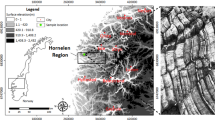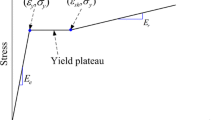Abstract
This paper presents a numerical study on the pullout behaviour of fully grouted rockbolts with bond defects. The cohesive zone model (CZM) is adopted to model the bond–slip behaviour between the rockbolt and grout material. Tensile tests were also conducted to validate the numerical model. The results indicate that the defect length can obviously influence the load and stress distributions along the rockbolt as well as the load–displacement response of the grouted system. Moreover, a plateau in the stress distribution forms due to the bond defect. The linear limit and peak load of the load–displacement response decrease as the defect length increases. A bond defect located closer to the loaded end leads to a longer nonlinear stage in the load–displacement response. However, the peak loads measured from the specimens made with various defect locations are almost approximately the same. The peak load for a specimen with the defects equally spaced along the bolt is higher than that for a specimen with defects concentrated in a certain zone, even with the same total defect length. Therefore, the dispersed pattern of bond defects would be much safer than the concentrated pattern. For the specimen with dispersed defects, the peak load increases with an increase in the defect spacing, even if the total defect length is the same. The peak load for a grouted rockbolt system with defects increases with an increases in the bolt diameter. This work leads to a better understanding of the load transfer mechanism for grouted rockbolt systems with bond defects, and paves the way towards developing a general evaluation method for damaged rockbolt grouted systems.
















Similar content being viewed by others
References
ABAQUS (2009) Theory manual, user manual and example manual, Version 6.9
Abramento M, Whittle JA (1995) Analysis of pullout tests for planar reinforcements in soil. J Geotech Eng 121(6):476–485
Barenblatt GI (1962) Mathematical theory of equilibrium cracks in brittle fracture. Adv Appl Mech 7:55–129
Bear MD, Lowe MJS (2003) Non-destructive testing of rock bolts using guided ultrasonic waves. Int J Rock Mech Min Sci 40:699–707
Cao C, Ren T, Cook C, Cao Y (2014a) Analytical approach in optimising selection of rebar bolts in preventing rock bolting failure. Int J Rock Mech Min Sci 72:16–25
Cao C, Ren T, Chris C (2014b) Introducing aggregate into grouting material and its influence on load transfer of the rock bolting system. Int J Min Sci Technol 24:325–328
Chang X, Yue GW, Lin HX, Tang CA (2010) Modeling the pullout behavior of fiber reinforced polymer bars from concrete. Constr Build Mater 24:431–437
Chen Y (2014) Experimental study and stress analysis of rock bolt anchorage performance. J Rock Mech Geotech Eng 6:428–437
Cox HL (1952) The elasticity and strength of paper and other fibrous materials. Br J Appl Phys 3:72–79
Cui Y, Zou DH (2006) Numerical simulation of attenuation and group velocity of guided ultrasonic wave in grouted rock bolts. J Appl Geophys 59(4):337–344
Cui Y, Zou DH (2012) Assessing the effects of insufficient rebar and missing grout in grouted rock bolts using guided ultrasonic waves. J Appl Geophys 79:64–70
Freeman TJ (1978) The behaviour of fully-bonded rock bolts in the Kielder experimental tunnel. Tunn Tunn 10:37–40
Dugdale D (1960) Yielding of steel sheets containing slits. J Mech Phys Solids 8: 100–104
Ghaboussi J, Wilson EL, Isenberg J (1973) Finite element for rock joint interfaces. J Soil Mech Found Div ASCE 99(SM10):833–848
Guan ZC, Jiang YJ, Tanabasi Y (2007) Reinforcement mechanics of passive bolts in conventional tunneling. Int J Rock Mech Min Sci 44:625–636
Hoek E, Wood DF (1989) Rock support. Int J Rock Mech Min Sci Geomech Abstr 26:282–287
Hyett AJ, Bawden WF, Reichert RD (1992) The effect of rock mass confinement on the bond strength of fully grouted cable bolts. Int J Rock Mech Min Sci Geomech Abstr 29(5):503–524
Hyett AJ, Bawden WF, Macsporran GR, Moosavi M (1995) A constitutive law for bond failure of fully-grouted cable bolts using a modified Hoek cell. Int J Rock Mech Min Sci Geomech Abstr 32(1):11–36
Hyett AJ, Mossavi M, Bawden W (1996) Load distribution along fully grouted bolts, with emphasis on cable bolt reinforcement. Int J Numer Anal Methods Geomech 20:517–544
Ivanovic A, Richard DN (2009) Modelling of debonding along the fixed anchor length. Int J Rock Mech Min Sci 46:699–707
Kim NK, Park JS, Kim SK (2007) Numerical simulation of ground anchors. Comput Geotech 30:498–507
Li X (2007) Finite element modeling of skewed reinforced concrete. (M.S. thesis). Auburn University
Li J, Kaliakin V (1993) Numerical simulation of interfaces in geomaterials: development of new zero-thickness interface elements. Civil engineering report no. 93–6. University of Delaware; 1993
Li C, Stillborg B (1999) Analytical models for rock bolts. Int J Rock Mech Min Sci 36:1013–1029
Madenga V, Zou DH, Zhang CS (2006) Effects of curing time and frequency on ultrasonic wave velocity in grouted rock bolts. J Appl Geophys 59(1):79–87
Nemcik J, Ma S, Aziz N, Ren T, Geng X (2014) Numerical modelling of failure propagation in fully grouted rock bolts subjected to tensile load. Int J Rock Mech Min Sci 71:293–300
Oded R (2008) Debonding analysis of fiber-reinforced-polymer strengthened beams: cohesive zone modeling versus a linear elastic fracture mechanics approach. Eng Fract Mech 75:2842–2859
Pavlakovic B, Lowe M, Cawley P (2001) High frequency low loss ultrasonic modes in imbedded bars. J Appl Mech 68:67–75
Ren FF, Yang ZJ, Chen JF, Chen WW (2010) An analytical analysis of the full-range behaviour of grouted rockbolts based on a tri-linear bond-slip model. Constr Build Mater 24:361–370
Stillborg B (1994) Professional users’ handbook for rock bolting, 2nd edn. Trans. Tech. Publications, Clausthal-Zellerfeld
Wang J (2006) Cohesive zone model of intermediate crack-induced debonding of FRP-plated concrete beam. Int J Solids Struct 43:6630–6648
Yazici S, Kaiser PK (1992) Bond strength of grouted cable bolts. Int J Rock Mech Min Sci Geomech Abstr 29(3):279–292
Zhang CS, Zou DH, Madenga V (2006) Numerical simulation of wave propagation in grouted rock bolts and the effects of mesh density and wave frequency. Int J Rock Mech Min Sci 43(4):634–639
Zhao Y, Yang M (2011) Pull-out behavior of an imperfectly bonded anchor system. Int J Rock Mech Min Sci 48:469–475
Acknowledgements
This work was fully supported by the National Natural Science Fund of China (Nos. 51304067, 51674100 and 51774112) and partly supported by the Distinguished Young Scholars of Henan Polytechnic University (No. J2015-1) and the Program for Science and Technology Innovation Talents Universities of Henan Province (Project No. 18HASTIT017). We are grateful to the reviewers for their constructive comments on the paper.
Author information
Authors and Affiliations
Corresponding author
Rights and permissions
About this article
Cite this article
Xu, C., Li, Z., Wang, S. et al. Pullout Performances of Grouted Rockbolt Systems with Bond Defects. Rock Mech Rock Eng 51, 861–871 (2018). https://doi.org/10.1007/s00603-017-1373-1
Received:
Accepted:
Published:
Issue Date:
DOI: https://doi.org/10.1007/s00603-017-1373-1




